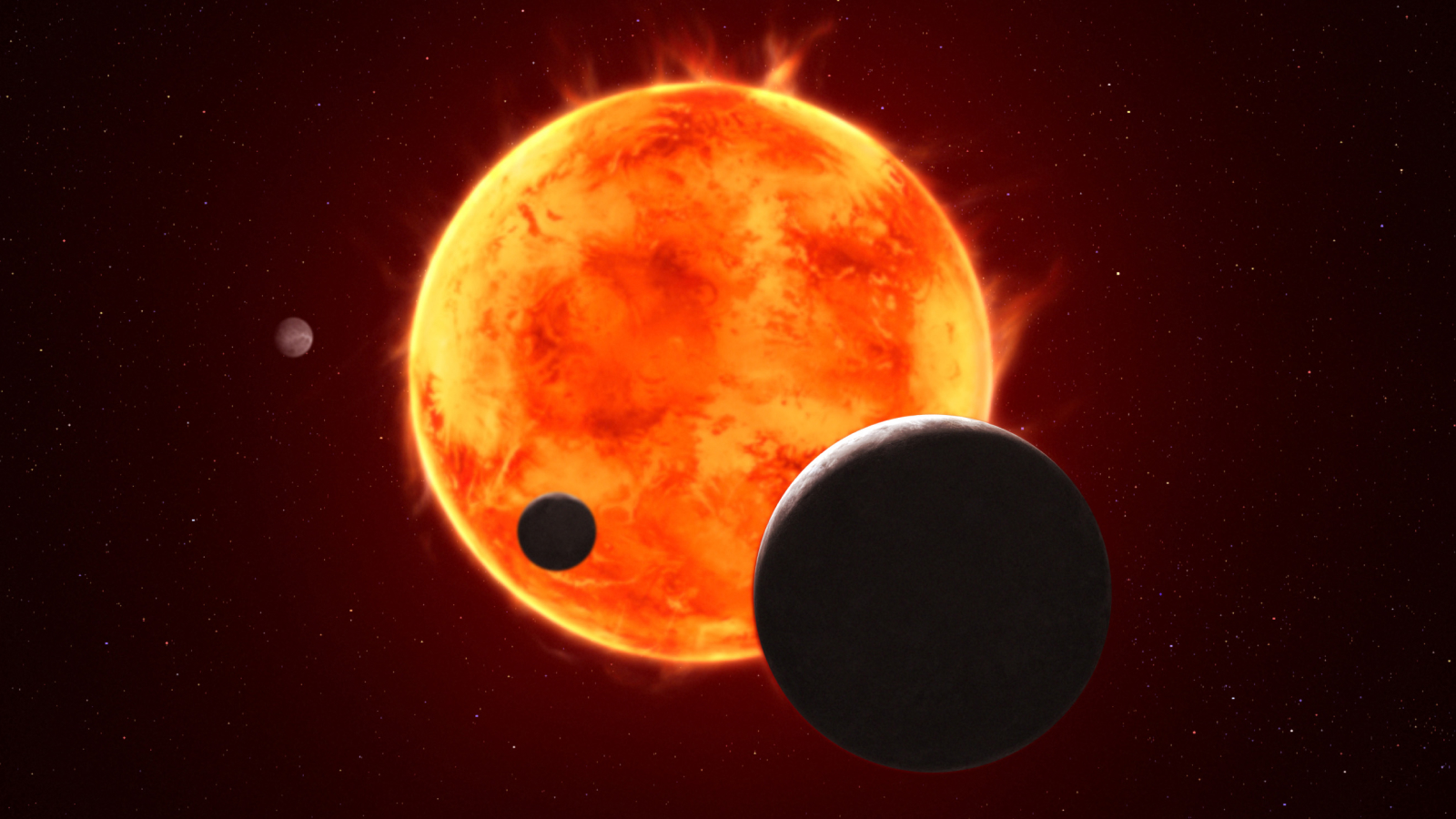Potentially habitable, Earth-size exoplanet TRAPPIST-1e may have an atmosphere, James Webb telescope hints
By Hannah Wakeford,Ryan Macdonald
Copyright livescience

Skip to main content
Close main menu
Live Science
Sign up to our newsletter
View Profile
Search Live Science
Planet Earth
Archaeology
Physics & Math
Human Behavior
Science news
Life’s Little Mysteries
Science quizzes
Newsletters
Story archive
COVID vaccine poll
Ant clones members of another species
JWST takes best image yet
Science history: Gravitational waves detected
Best star projecter
Don’t miss these
‘The most significant JWST finding to date’: James Webb spots — then loses — a giant planet orbiting in the habitable zone of our closest sun-like star
5th planet found orbiting nearby star may lie in habitable zone
Extraterrestrial Life
Chinese scientists hunt for alien radio signals in ‘potentially habitable’ TRAPPIST-1 system
JWST finds planet with all-carbon atmosphere orbiting ‘black widow’ star
James Webb telescope discovers its first planet — a Saturn-size ‘shepherd’ still glowing red hot from its formation
JWST spies frigid alien world on bizarre orbit: ‘One of the coldest, oldest and faintest planets that we’ve imaged to date’
James Webb telescope spots odd disk around star that could shatter planet formation theories
Stunning ‘sun dogs’ could sparkle in alien skies, James Webb Space Telescope suggests
Astronomers discover monster exoplanet hiding in ‘stellar fog’ around young star
James Webb telescope images reveal there’s something strange with interstellar comet 3I/ATLAS
Oops! Earendel, most distant star ever discovered, may not actually be a star, James Webb Telescope reveals
‘A completely new phenomenon’: Astronomers spot a planet causing its star to constantly explode
Bad news for alien life? Earth-size planets may be less common than we thought
Scientists detect gargantuan ‘pimple’ that has plagued a star for at least 7 years
Astronomers spot alien planet system being born before their eyes
Potentially habitable, Earth-size exoplanet TRAPPIST-1e may have an atmosphere, James Webb telescope hints
Hannah Wakeford, Ryan MacDonald
15 September 2025
Scientists studying the rocky exoplanet TRAPPIST-1e may have found hints of an atmosphere. If confirmed, it could be an important step toward finding a habitable world outside our solar system.
When you purchase through links on our site, we may earn an affiliate commission. Here’s how it works.
An illustration of the TRAPPIST-1 system, the most-studied star system outside of our own.
(Image credit: Illustration: NASA, ESA, CSA, STScI, Joseph Olmsted (STScI))
New research using the powerful JWST telescope has identified a planet 41 light-years away which may have an atmosphere. The planet is within the “habitable zone”, the region around a star where temperatures make it possible for liquid water to exist on the surface of a rocky world. This is important because water is a key ingredient that supports the existence of life.
If confirmed by further observations, this would be the first rocky, habitable zone planet that’s also known to host an atmosphere. The findings come from two new studies published in the journal Astrophysical Journal Letters.
The habitable zone is partly defined by the range of temperatures generated by heat from the star. The zone is located at a distance from its star where temperatures are neither too hot nor too cold (leading to it occasionally being nicknamed “the Goldilocks zone”).
You may like
‘The most significant JWST finding to date’: James Webb spots — then loses — a giant planet orbiting in the habitable zone of our closest sun-like star
5th planet found orbiting nearby star may lie in habitable zone
Chinese scientists hunt for alien radio signals in ‘potentially habitable’ TRAPPIST-1 system
But exoplanets (worlds orbiting stars outside our solar system) capable of hosting liquid water often also need an atmosphere with a sufficient greenhouse effect. The greenhouse effect generates additional heating due to absorption and emission from gases in the atmosphere and will help prevent evaporation of water into space.
Together with an international team of colleagues, we trained the largest telescope in space, Nasa’s JWST, on a planet called Trappist-1 e. We wanted to determine whether this rocky world, which lies in its star’s habitable zone, hosts an atmosphere. The planet is one of seven rocky worlds known to orbit a small, cool “red dwarf” star called Trappist-1.
Rocky exoplanets are everywhere in our galaxy. The discovery of abundant rocky planets in the 2010s by the Kepler and Tess space telescopes has profound implications for our place in the Universe.
Related: Will the James Webb telescope lead us to alien life? Scientists say we’re getting closer than ever.
Sign up for the Live Science daily newsletter now
Get the world’s most fascinating discoveries delivered straight to your inbox.
Contact me with news and offers from other Future brandsReceive email from us on behalf of our trusted partners or sponsorsBy submitting your information you agree to the Terms & Conditions and Privacy Policy and are aged 16 or over.
Most of the rocky exoplanets we’ve found so far orbit red dwarf stars, which are much cooler than the Sun (typically 2500°C/4,500°F, compared to the Sun’s 5,600°C/10,000°F). This isn’t because planets around Sun-like stars are rare, there are just technical reasons why it is easier to find and study planets orbiting smaller stars.
Red dwarfs also offer many advantages when we seek to measure the properties of their planets. Because the stars are cooler, their habitable zones, where temperatures are favourable to liquid water, are located much closer in comparison with our solar system, because the Sun is much hotter. As such, a year for a rocky planet with the temperature of Earth that orbits a red dwarf star can be just a few days to a week compared to Earth’s 365 days.
Transit method
One way to detect exoplanets is to measure the slight dimming of light when the planet transits, or passes in front of, its star. Because planets orbiting red dwarfs take less time to complete an orbit, astronomers can observe more transits in a shorter space of time, making it easier to gather data.
You may like
‘The most significant JWST finding to date’: James Webb spots — then loses — a giant planet orbiting in the habitable zone of our closest sun-like star
5th planet found orbiting nearby star may lie in habitable zone
Chinese scientists hunt for alien radio signals in ‘potentially habitable’ TRAPPIST-1 system
During a transit, astronomers can measure absorption from gases in the planet’s atmosphere (if it has one). Absorption refers to the process whereby certain gases absorb light at different wavelengths, preventing it from passing through. This provides scientists with a way of detecting which gases are present in an atmosphere.
Crucially, the smaller the star, the greater the fraction of its light is blocked by a planet’s atmosphere during transit. So red dwarf stars are one of the best places for us to look for the atmospheres of rocky exoplanets.
Located at a relatively close distance of 41 light years from Earth, the Trappist-1 system has attracted significant attention since its discovery in 2016. Three of the planets, Trappist-1d, Trappist-1e, and Trappist-1f (the third, fourth, and fifth planets from the star) lie within the habitable zone.
JWST has been conducting a systematic search for atmospheres on the Trappist-1 planets since 2022. The results for the three innermost planets, Trappist-1b, Trappist-1c and Trappist-1d, point to these worlds most likely being bare rocks with thin atmospheres at best. But the planets further out, which are bombarded with less radiation and energetic flares from the star, could still potentially possess atmospheres.
We observed Trappist-1e, the planet in the centre of the star’s habitable zone, with JWST on four separate occasions from June-October 2023. We immediately noticed that our data was strongly affected by what’s known as “stellar contamination” from hot and cold active regions (similar to sunspots) on Trappist-1. This required a careful analysis to deal with. In the end, it took our team over a year to sift through the data and distinguish the signal coming from the star from that of the planet.
This transmission spectrum graph compares data collected by the NIRSpec instrument on NASA’s James Webb Space Telescope with computer models of exoplanet TRAPPIST-1 e with (blue) and without (orange) an atmosphere. (Image credit: NASA, ESA, CSA, STScI, Joseph Olmsted (STScI))
We are seeing two possible explanations for what’s going on at Trappist-1e. The most exciting possibility is that the planet has a so-called secondary atmosphere containing heavy molecules such as nitrogen and methane. But the four observations we obtained aren’t yet precise enough to rule out the alternative explanation of the planet being a bare rock with no atmosphere.
Should Trappist-1e indeed have an atmosphere, it will be the first time we have found an atmosphere on a rocky planet in the habitable zone of another star.
Since Trappist-1e lies firmly in the habitable zone, a thick atmosphere with a sufficient greenhouse effect could allow for liquid water on the planet’s surface. To establish whether or not Trappist-1e is habitable, we will need to measure the concentrations of greenhouse gases like carbon dioxide and methane. These initial observations are an important step in that direction, but more observations with JWST will be needed to be sure if Trappist-1e has an atmosphere and, if so, to measure the concentrations of these gases.
RELATED STORIES
—A real-life Pandora? Newfound ‘disappearing’ planet in our neighboring star system could have a habitable moon, just like the Avatar movies
—Apophis flyby in 2029 will be the first time a potentially hazardous asteroid has been visible to the naked eye
—NASA rover spots bizarre ‘turtle’ hiding among ancient rocks on Mars
As we speak, an additional 15 transits of Trappist-1e are underway and should be complete by the end of 2025. Our follow-up observations use a different observing strategy where we target consecutive transits of Trappist-1b (which is a bare rock) and Trappist-1e. This will allow us to use the bare rock to better “trace out” the hot and cold active regions on the star. Any excess absorption of gases seen only during Trappist-1e’s transits will be uniquely caused by the planet’s atmosphere.
So within the next two years, we should have a much better picture of how Trappist-1e compares to the rocky planets in our solar system.
This edited article is republished from The Conversation under a Creative Commons license. Read the original article.
Ryan MacDonald
Lecturer in Extrasolar Planets, University of St Andrews
You must confirm your public display name before commenting
Please logout and then login again, you will then be prompted to enter your display name.
‘The most significant JWST finding to date’: James Webb spots — then loses — a giant planet orbiting in the habitable zone of our closest sun-like star
5th planet found orbiting nearby star may lie in habitable zone
Chinese scientists hunt for alien radio signals in ‘potentially habitable’ TRAPPIST-1 system
JWST finds planet with all-carbon atmosphere orbiting ‘black widow’ star
James Webb telescope discovers its first planet — a Saturn-size ‘shepherd’ still glowing red hot from its formation
JWST spies frigid alien world on bizarre orbit: ‘One of the coldest, oldest and faintest planets that we’ve imaged to date’
Latest in Space
Science history: Gravitational waves detected, proving Einstein right — Sept. 14, 2015
Astronomers use rare ‘double zoom’ to view black hole corona in unprecedented detail
Chinese scientists hunt for alien radio signals in ‘potentially habitable’ TRAPPIST-1 system
JWST finds planet with all-carbon atmosphere orbiting ‘black widow’ star
New ‘quasi-moon’ discovered in Earth orbit may have been hiding there for decades
James Webb telescope’s ‘starlit mountaintop’ could be the observatory’s best image yet — Space photo of the week
Latest in Opinion
‘Your fear is well-founded’: How human activities have raised the risk of tick-borne diseases like Lyme
How the surface you exercise on might increase your risk of cramps
‘Serious adverse and unintended consequences’: Polar geoengineering isn’t the answer to climate change
TRAPPIST-1e might have an atmosphere, JWST hints
RFK Jr. wants to overhaul the country’s ‘vaccine court.’ Here’s what stands in his way.
Unpacking RFK Jr.’s (many) false claims about COVID vaccines
LATEST ARTICLES
The best star projector we’ve tested is 38% cheaper on Amazon, taking it to one of its lowest-ever prices
Pawnee Star Chart: A precontact elk-skin map used by Indigenous priests to tell an origin story
Where is Queen Boudica buried?
AI could use online images as a backdoor into your computer, alarming new study suggests
‘Your fear is well-founded’: How human activities have raised the risk of tick-borne diseases like Lyme
Live Science is part of Future US Inc, an international media group and leading digital publisher. Visit our corporate site.
Contact Future’s experts
Terms and conditions
Privacy policy
Cookies policy
Accessibility Statement
Advertise with us
Web notifications
Editorial standards
How to pitch a story to us
Future US, Inc. Full 7th Floor, 130 West 42nd Street,
Please login or signup to comment
Please wait…



